ECU PONTIAC VIBE 2010 User Guide
[x] Cancel search | Manufacturer: PONTIAC, Model Year: 2010, Model line: VIBE, Model: PONTIAC VIBE 2010Pages: 318, PDF Size: 1.7 MB
Page 41 of 318
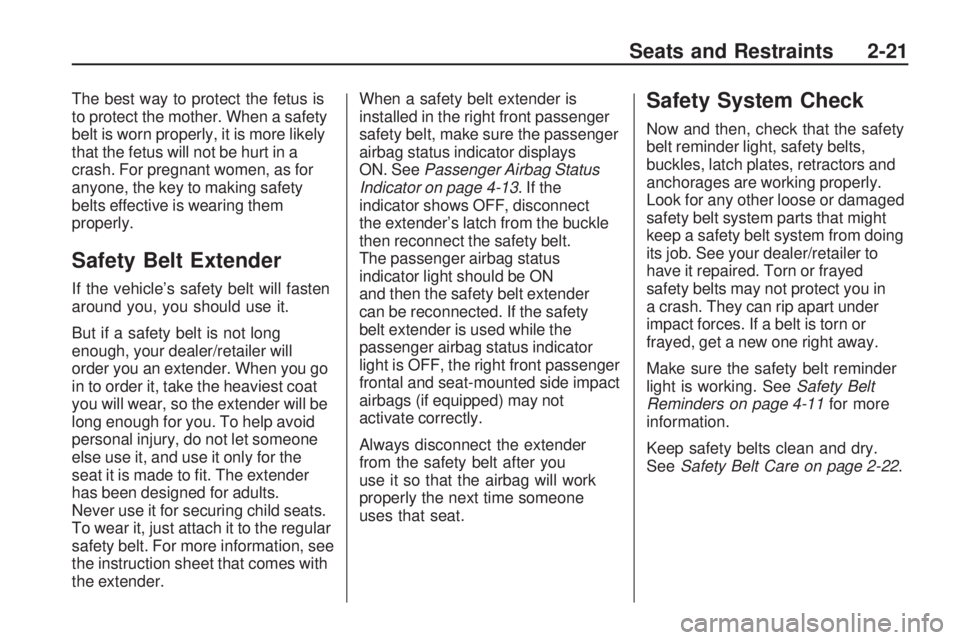
The best way to protect the fetus is
to protect the mother. When a safety
belt is worn properly, it is more likely
that the fetus will not be hurt in a
crash. For pregnant women, as for
anyone, the key to making safety
belts effective is wearing them
properly.
Safety Belt Extender
If the vehicle’s safety belt will fasten
around you, you should use it.
But if a safety belt is not long
enough, your dealer/retailer will
order you an extender. When you go
in to order it, take the heaviest coat
you will wear, so the extender will be
long enough for you. To help avoid
personal injury, do not let someone
else use it, and use it only for the
seat it is made to fit. The extender
has been designed for adults.
Never use it for securing child seats.
To wear it, just attach it to the regular
safety belt. For more information, see
the instruction sheet that comes with
the extender.When a safety belt extender is
installed in the right front passenger
safety belt, make sure the passenger
airbag status indicator displays
ON. See
Passenger Airbag Status
Indicator on page 4-13 .Ifthe
indicator shows OFF, disconnect
the extender’s latch from the buckle
then reconnect the safety belt.
The passenger airbag status
indicator light should be ON
and then the safety belt extender
can be reconnected. If the safety
belt extender is used while the
passenger airbag status indicator
light is OFF, the right front passenger
frontal and seat-mounted side impact
airbags (if equipped) may not
activate correctly.
Always disconnect the extender
from the safety belt after you
use it so that the airbag will work
properly the next time someone
uses that seat.
Safety System Check
Now and then, check that the safety
belt reminder light, safety belts,
buckles, latch plates, retractors and
anchorages are working properly.
Look for any other loose or damaged
safety belt system parts that might
keep a safety belt system from doing
its job. See your dealer/retailer to
have it repaired. Torn or frayed
safety belts may not protect you in
a crash. They can rip apart under
impact forces. If a belt is torn or
frayed, get a new one right away.
Make sure the safety belt reminder
light is working. See Safety Belt
Reminders on page 4-11 for more
information.
Keep safety belts clean and dry.
See Safety Belt Care on page 2-22 .
Seats and Restraints 2-21
Page 44 of 318
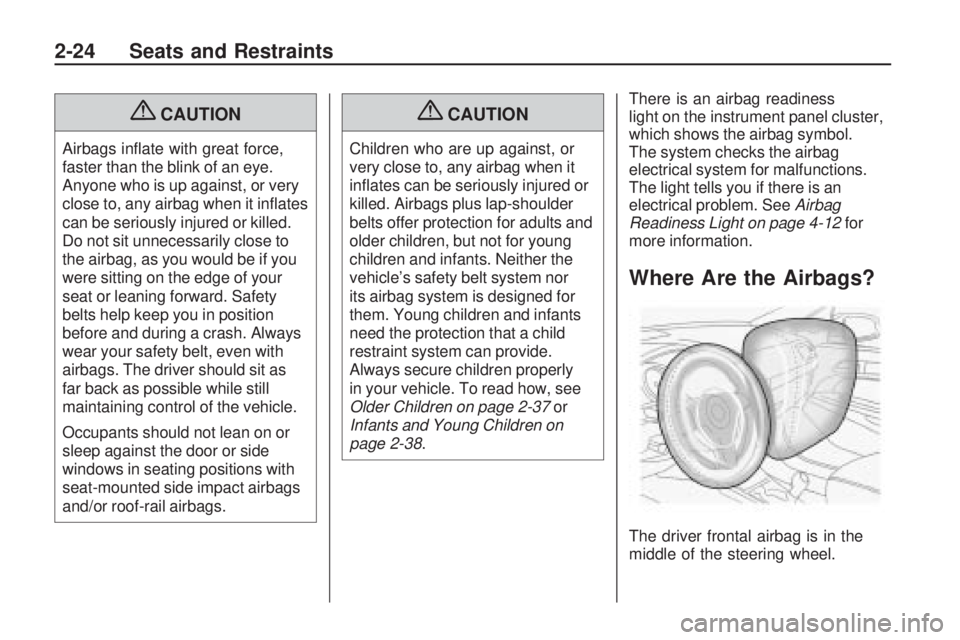
{CAUTION
Airbags inflate with great force,
faster than the blink of an eye.
Anyone who is up against, or very
close to, any airbag when it inflates
can be seriously injured or killed.
Do not sit unnecessarily close to
the airbag, as you would be if you
were sitting on the edge of your
seat or leaning forward. Safety
belts help keep you in position
before and during a crash. Always
wear your safety belt, even with
airbags. The driver should sit as
far back as possible while still
maintaining control of the vehicle.
Occupants should not lean on or
sleep against the door or side
windows in seating positions with
seat-mounted side impact airbags
and/or roof-rail airbags.
{CAUTION
Children who are up against, or
very close to, any airbag when it
inflates can be seriously injured or
killed. Airbags plus lap-shoulder
belts offer protection for adults and
older children, but not for young
children and infants. Neither the
vehicle’s safety belt system nor
its airbag system is designed for
them. Young children and infants
need the protection that a child
restraint system can provide.
Always secure children properly
in your vehicle. To read how, see
Older Children on page 2-37or
Infants and Young Children on
page 2-38. There is an airbag readiness
light on the instrument panel cluster,
which shows the airbag symbol.
The system checks the airbag
electrical system for malfunctions.
The light tells you if there is an
electrical problem. See
Airbag
Readiness Light on page 4-12 for
more information.
Where Are the Airbags?
The driver frontal airbag is in the
middle of the steering wheel.
2-24 Seats and Restraints
Page 45 of 318
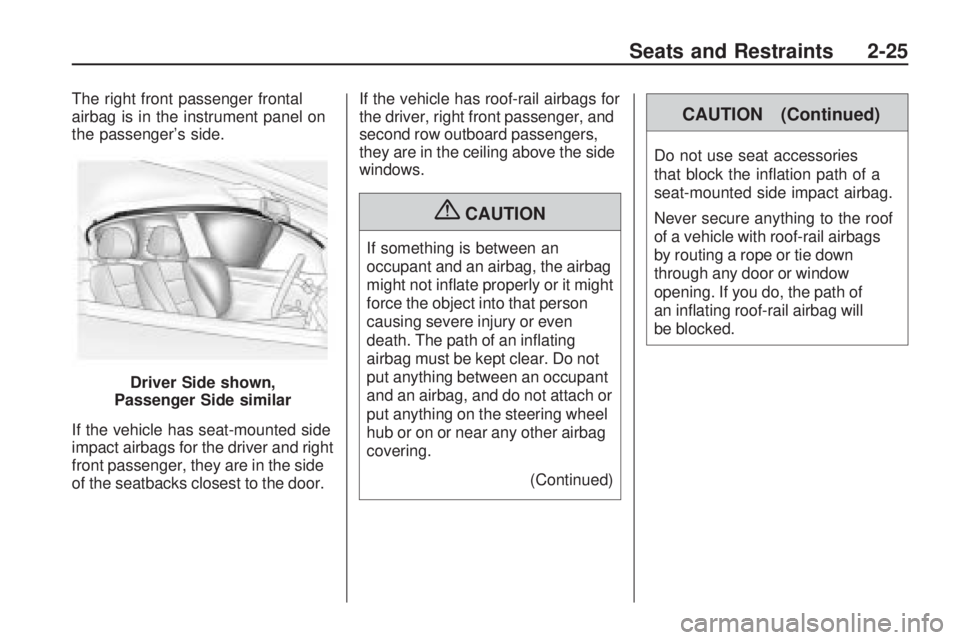
The right front passenger frontal
airbag is in the instrument panel on
the passenger’s side.
If the vehicle has seat-mounted side
impact airbags for the driver and right
front passenger, they are in the side
of the seatbacks closest to the door.If the vehicle has roof-rail airbags for
the driver, right front passenger, and
second row outboard passengers,
they are in the ceiling above the side
windows.
{CAUTION
If something is between an
occupant and an airbag, the airbag
might not inflate properly or it might
force the object into that person
causing severe injury or even
death. The path of an inflating
airbag must be kept clear. Do not
put anything between an occupant
and an airbag, and do not attach or
put anything on the steering wheel
hub or on or near any other airbag
covering.
(Continued)
CAUTION (Continued)
Do not use seat accessories
that block the inflation path of a
seat-mounted side impact airbag.
Never secure anything to the roof
of a vehicle with roof-rail airbags
by routing a rope or tie down
through any door or window
opening. If you do, the path of
an inflating roof-rail airbag will
be blocked.
Driver Side shown,
Passenger Side similar
Seats and Restraints 2-25
Page 50 of 318

The sensors are designed to detect
the presence of a properly-seated
occupant and determine if the right
front passenger frontal airbag and
seat-mounted side impact airbag
(if equipped) should be enabled
(may inflate) or not.
According to accident statistics,
children and infants are safer
when properly restrained in a child
restraint system or infant restraint
system secured in a rear seating
position.
We recommend that children be
secured in a rear seat, including:
an infant or a child riding in a
rear-facing child restraint; a child
riding in a forward-facing child seat;
an older child riding in a booster
seat; and children, who are
large enough, using safety belts.A label on the sun visor says,
“Never put a rear-facing child seat
in the front.” This is because the risk
to the rear-facing child is so great,
if the airbag deploys.
{CAUTION
A child in a rear-facing child
restraint can be seriously injured or
killed if the right front passenger
airbag inflates. This is because
the back of the rear-facing child
restraint would be very close to
the inflating airbag. A child in a
forward-facing child restraint can
be seriously injured or killed if
the right front passenger airbag
inflates and the passenger seat
is in a forward position.
(Continued)
CAUTION (Continued)
Even if the passenger sensing
system has turned off the right
front passenger frontal airbag
and seat-mounted side impact
airbag (if equipped), no system
is fail-safe. No one can guarantee
that an airbag will not deploy
under some unusual
circumstance, even though
the airbag(s) are off.
Secure rear-facing child restraints
in a rear seat, even if the airbag(s)
are off. If you secure a
forward-facing child restraint in the
right front seat, always move the
front passenger seat as far back as
it will go. It is better to secure the
child restraint in a rear seat.
2-30 Seats and Restraints
Page 52 of 318

If the airbag readiness light and the
OFF light in the passenger airbag
status indicator come on together,
it may mean there is a malfunction
in the passenger sensing system.
Secure the child in the child restraint
in a rear seat position in the vehicle
and check with your dealer/retailer.
{CAUTION
If the airbag readiness light ever
comes on and stays on, it means
that something may be wrong with
the airbag system. To help avoid
injury to yourself or others, have
the vehicle serviced right away.
SeeAirbag Readiness Light on
page 4-12 for more information,
including important safety
information.
If the On Indicator is Lit for a
Child Restraint
If a child restraint has been installed
and the on indicator is lit:
1. Turn the vehicle off.
2. Remove the child restraint from the vehicle.
3. Remove any additional items from the seat such as blankets,
cushions, seat covers, seat
heaters, or seat massagers.
4. Reinstall the child restraint with the ignition key in the ACC or
LOCK position while following the
directions provided by the child
restraint manufacturer and refer
toSecuring Child Restraints
(Rear Seat Position) on
page 2-51 orSecuring Child
Restraints (Right Front Seat
Position) on page 2-53 .5. If, after reinstalling the child
restraint and restarting the
vehicle, the on indicator is still lit,
turn the vehicle off. Then slightly
recline the vehicle seatback
and adjust the seat cushion, if
adjustable, to make sure that the
vehicle seatback is not pushing
the child restraint into the seat
cushion.
6. Also make sure the child restraint is not trapped under the vehicle
head restraint. If this happens,
adjust the head restraint.
See Head Restraints on
page 2-2.
If the on indicator is still lit, secure
the child in the child restraint in
a rear seat position in the vehicle,
and check with your dealer/retailer.
2-32 Seats and Restraints
Page 57 of 318
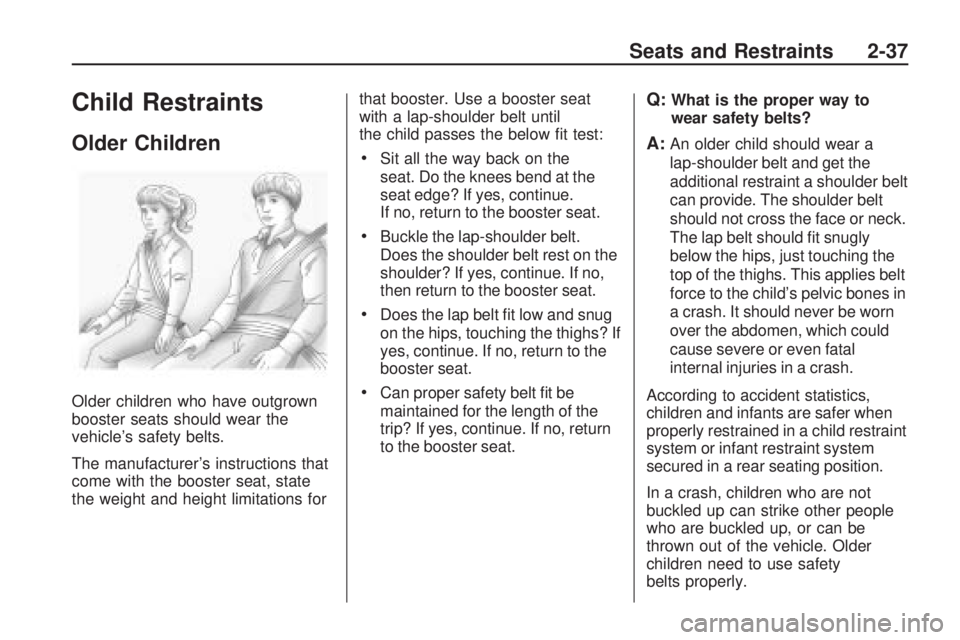
Child Restraints
Older Children
Older children who have outgrown
booster seats should wear the
vehicle’s safety belts.
The manufacturer’s instructions that
come with the booster seat, state
the weight and height limitations forthat booster. Use a booster seat
with a lap-shoulder belt until
the child passes the below fit test:
•Sit all the way back on the
seat. Do the knees bend at the
seat edge? If yes, continue.
If no, return to the booster seat.
•Buckle the lap-shoulder belt.
Does the shoulder belt rest on the
shoulder? If yes, continue. If no,
then return to the booster seat.
•Does the lap belt fit low and snug
on the hips, touching the thighs? If
yes, continue. If no, return to the
booster seat.
•Can proper safety belt fit be
maintained for the length of the
trip? If yes, continue. If no, return
to the booster seat.
Q:What is the proper way to
wear safety belts?
A:An older child should wear a
lap-shoulder belt and get the
additional restraint a shoulder belt
can provide. The shoulder belt
should not cross the face or neck.
The lap belt should fit snugly
below the hips, just touching the
top of the thighs. This applies belt
force to the child’s pelvic bones in
a crash. It should never be worn
over the abdomen, which could
cause severe or even fatal
internal injuries in a crash.
According to accident statistics,
children and infants are safer when
properly restrained in a child restraint
system or infant restraint system
secured in a rear seating position.
In a crash, children who are not
buckled up can strike other people
who are buckled up, or can be
thrown out of the vehicle. Older
children need to use safety
belts properly.
Seats and Restraints 2-37
Page 59 of 318
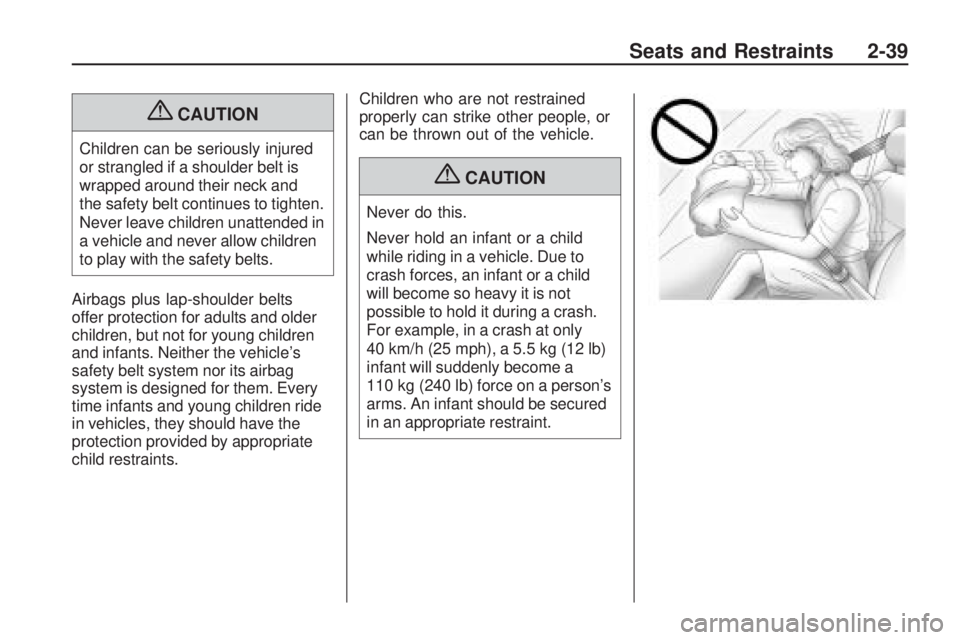
{CAUTION
Children can be seriously injured
or strangled if a shoulder belt is
wrapped around their neck and
the safety belt continues to tighten.
Never leave children unattended in
a vehicle and never allow children
to play with the safety belts.
Airbags plus lap-shoulder belts
offer protection for adults and older
children, but not for young children
and infants. Neither the vehicle’s
safety belt system nor its airbag
system is designed for them. Every
time infants and young children ride
in vehicles, they should have the
protection provided by appropriate
child restraints. Children who are not restrained
properly can strike other people, or
can be thrown out of the vehicle.
{CAUTION
Never do this.
Never hold an infant or a child
while riding in a vehicle. Due to
crash forces, an infant or a child
will become so heavy it is not
possible to hold it during a crash.
For example, in a crash at only
40 km/h (25 mph), a 5.5 kg (12 lb)
infant will suddenly become a
110 kg (240 lb) force on a person’s
arms. An infant should be secured
in an appropriate restraint.
Seats and Restraints 2-39
Page 60 of 318
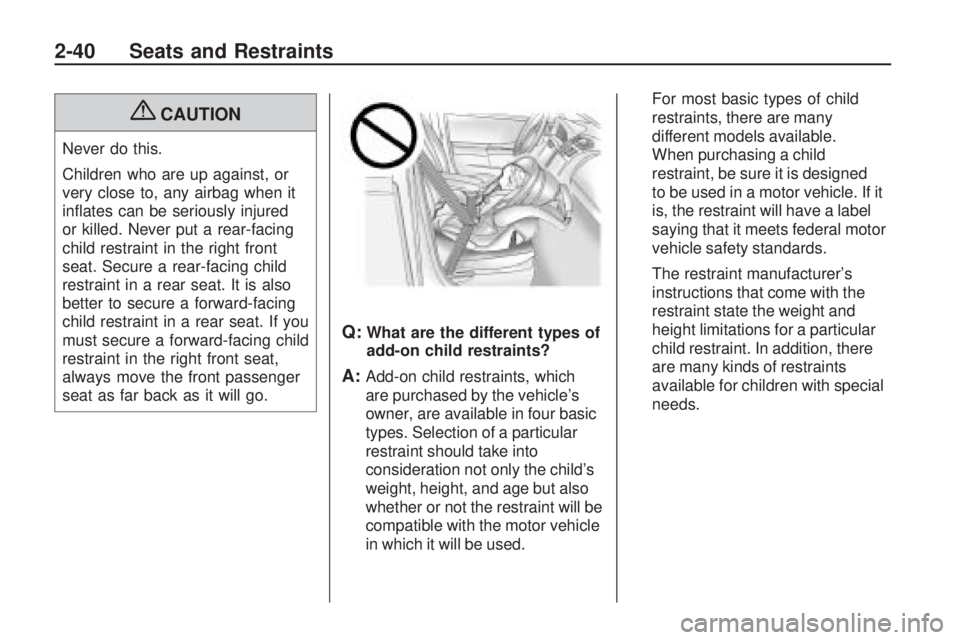
{CAUTION
Never do this.
Children who are up against, or
very close to, any airbag when it
inflates can be seriously injured
or killed. Never put a rear-facing
child restraint in the right front
seat. Secure a rear-facing child
restraint in a rear seat. It is also
better to secure a forward-facing
child restraint in a rear seat. If you
must secure a forward-facing child
restraint in the right front seat,
always move the front passenger
seat as far back as it will go.
Q:What are the different types of
add-on child restraints?
A:Add-on child restraints, which
are purchased by the vehicle’s
owner, are available in four basic
types. Selection of a particular
restraint should take into
consideration not only the child’s
weight, height, and age but also
whether or not the restraint will be
compatible with the motor vehicle
in which it will be used. For most basic types of child
restraints, there are many
different models available.
When purchasing a child
restraint, be sure it is designed
to be used in a motor vehicle. If it
is, the restraint will have a label
saying that it meets federal motor
vehicle safety standards.
The restraint manufacturer’s
instructions that come with the
restraint state the weight and
height limitations for a particular
child restraint. In addition, there
are many kinds of restraints
available for children with special
needs.
2-40 Seats and Restraints
Page 61 of 318
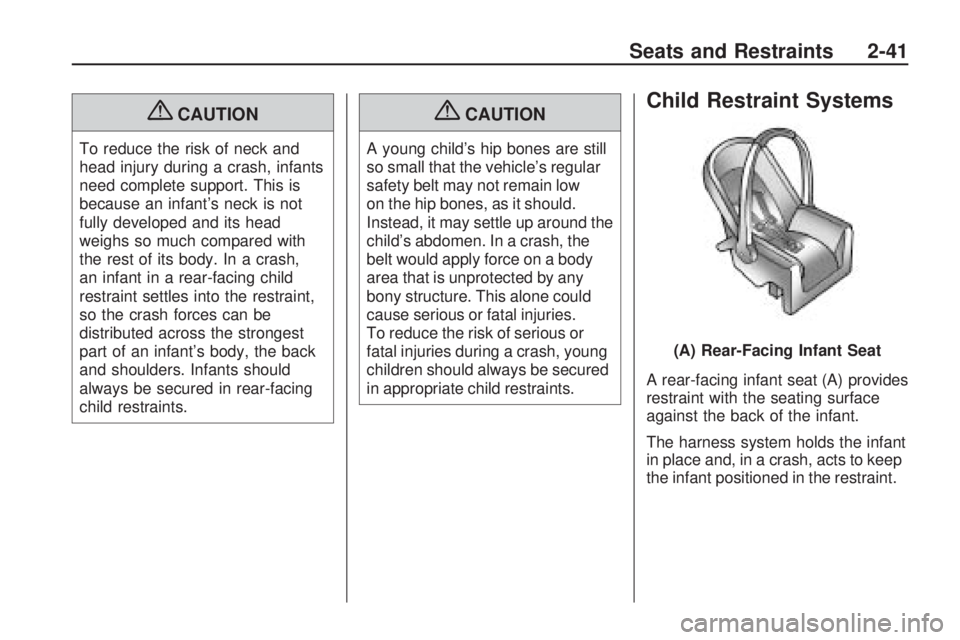
{CAUTION
To reduce the risk of neck and
head injury during a crash, infants
need complete support. This is
because an infant’s neck is not
fully developed and its head
weighs so much compared with
the rest of its body. In a crash,
an infant in a rear-facing child
restraint settles into the restraint,
so the crash forces can be
distributed across the strongest
part of an infant’s body, the back
and shoulders. Infants should
always be secured in rear-facing
child restraints.
{CAUTION
A young child’s hip bones are still
so small that the vehicle’s regular
safety belt may not remain low
on the hip bones, as it should.
Instead, it may settle up around the
child’s abdomen. In a crash, the
belt would apply force on a body
area that is unprotected by any
bony structure. This alone could
cause serious or fatal injuries.
To reduce the risk of serious or
fatal injuries during a crash, young
children should always be secured
in appropriate child restraints.
Child Restraint Systems
A rear-facing infant seat (A) provides
restraint with the seating surface
against the back of the infant.
The harness system holds the infant
in place and, in a crash, acts to keep
the infant positioned in the restraint.(A) Rear-Facing Infant Seat
Seats and Restraints 2-41
Page 62 of 318
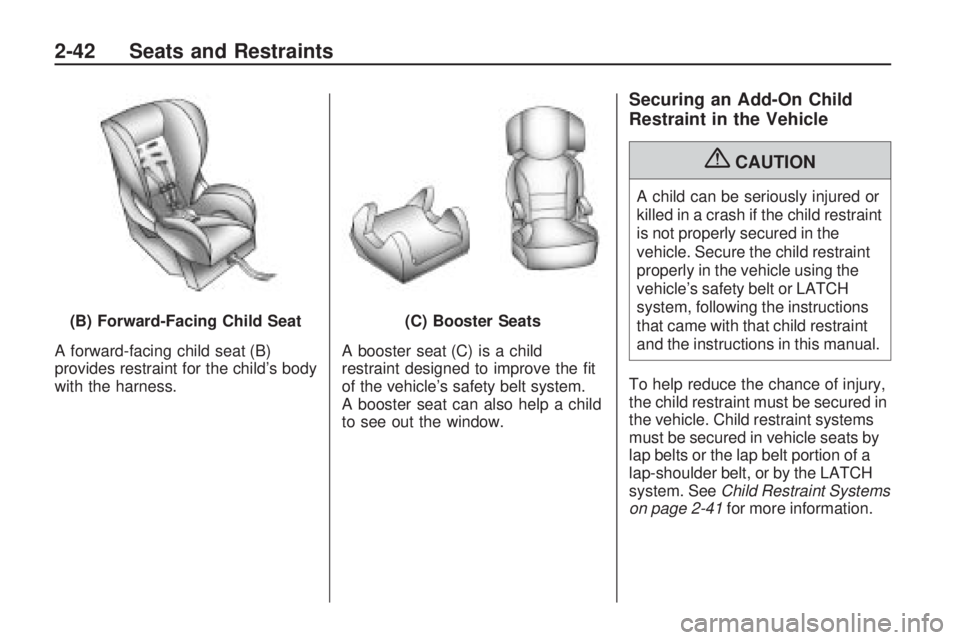
A forward-facing child seat (B)
provides restraint for the child’s body
with the harness.A booster seat (C) is a child
restraint designed to improve the fit
of the vehicle’s safety belt system.
A booster seat can also help a child
to see out the window.
Securing an Add-On Child
Restraint in the Vehicle
{CAUTION
A child can be seriously injured or
killed in a crash if the child restraint
is not properly secured in the
vehicle. Secure the child restraint
properly in the vehicle using the
vehicle’s safety belt or LATCH
system, following the instructions
that came with that child restraint
and the instructions in this manual.
To help reduce the chance of injury,
the child restraint must be secured in
the vehicle. Child restraint systems
must be secured in vehicle seats by
lap belts or the lap belt portion of a
lap-shoulder belt, or by the LATCH
system. See Child Restraint Systems
on page 2-41 for more information.
(B) Forward-Facing Child Seat
(C) Booster Seats
2-42 Seats and Restraints